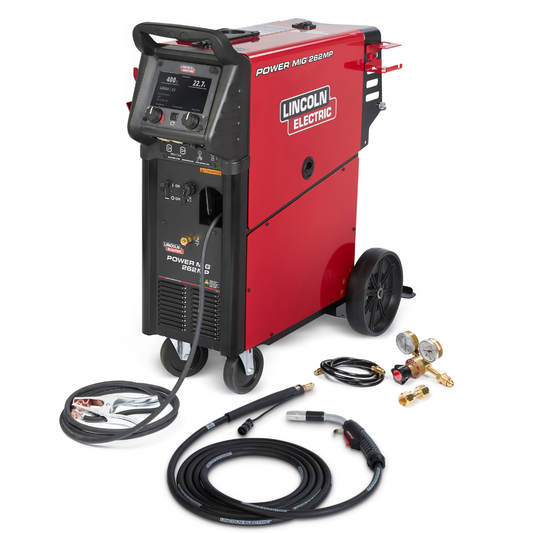The pros and cons of MIG welding usually depend on the type of MIG welder and the nature of the job. Before reviewing the advantages and disadvantages, it’s important to understand which MIG welder to use and what it will be used for.

MIG welders come in 1-phase, combination 1 and 3-phase, and 3-phase options. The 1-phase MIG welders typically have 115 or 230 VAC which suits home garages, auto body shops, farms, ranches, small maintenance work, general repairs, art studios, and light fabrication.
The 1 and 3-phase MIG welders provide more flexibility for welding in different industries. They have the power to accomplish the same things as a 1-phase MIG welder and can also be used for light manufacturing and fabrication. You can browse a variety of 1 and 3-phase MIG welders here.
Once you identify the right MIG welder for the work you are doing, you will be able to evaluate the advantages and disadvantages. Many welders would argue that the pros outweigh the cons.
Pros:
Higher Productivity
Many welders will experience increased productivity with the time saved by not having to constantly change rods, chip away slag, or repeatedly brush the weld. With the time saved, they are able to work faster and cleaner.
Easy to Learn
One of the biggest advantages of MIG welding is its simplicity. Welders can learn how to MIG weld in a few hours, with some instructors claiming they can provide basic training in twenty minutes— with the majority of the time being spent on cleaning the weld! TIG welding involves more training and can take longer to learn, so most home-based welders don’t invest the time into it. Some instructors describe MIG welding as a “point and shoot” process.

Simple and Great Welds
MIG welding results in better weld pool visibility. Along with the simplicity of the process and better control offered by the auto-feed wire, MIG makes it easy to produce a great-looking weld.
Clean and Efficient
With MIG welding there is very little loss of alloying elements as the metal transfers across the arc due to the shielding gas used to protect the arc. Only minor weld spatter is produced and there is no slag to remove, which is typical for stick welding. MIG welders will be back on the job in a fraction of the time thanks to the minimal clean-up time, especially if you're using Blue Demon Anti-Spatter Shield Spray
Versatile
MIG welding is extremely versatile with the ability to weld a broad range of metals and alloys with options for both semi and fully automatic operations. Whether you are tackling a home improvement project or working in an industrial setting, MIG welding offers the most flexibility. MIG is used for the following metals: aluminum, copper, stainless steel, mild steel, magnesium, nickel, and many of their alloys, as well as iron and most of its alloys.
Faster Welding Speed
With the continuous wire feed, you can keep both hands free for MIG welding which improves speed, weld quality, and overall control.
Fast Cooling Rates
MIG Welding does not cover the weld in slag once completed, leading to faster cooling rates and more efficiency.
Cons:
Cost
Welders will notice right away that MIG equipment tends to be more complex and costly compared to other welding methods. Additionally, the cost of shielding gas, electrodes, and replacement tips and nozzles can add up over time.
Limited Positions
The fluidity of the welding puddle and the high heat input of the MIG welder make it less suitable for vertical or overhead positions. If your projects involve welding in these challenging positions, it’s important to evaluate whether a MIG welder will meet your needs.
Unsuitable for Outdoor Welding
MIG welders are not ideal for outdoor use because they rely on shielding gas to maintain weld purity. Wind can disrupt the shielding gas and compromise the weld quality. For outdoor repairs or fieldwork, a MIG welder may not be practical, though it's excellent for garage-based automotive projects.
Shielding Gas
The bottle of shielding gas used to MIG weld can be time-consuming to replace and can get in the way while welding. It is a good idea to consider where you will store the shielding gas tank.

Unsuitable for Thick Metals
While MIG welding is suitable for thin metals, it does not deliver proper penetration for thicker steel that requires a solid weld.
Metal Preparation Time
Before welding with a MIG welder, the material has to be free of rust or dirt in order to get a good weld and for safety’s sake.
At Baker's Gas and Welding, we offer a wide range of MIG welders. For any questions or quotes, don't hesitate to reach out to Baker's Gas and Welding by calling 877-930-5690 or by emailing suppot@bakersgas.com. Our team is here to help you build the perfect welding setup!




